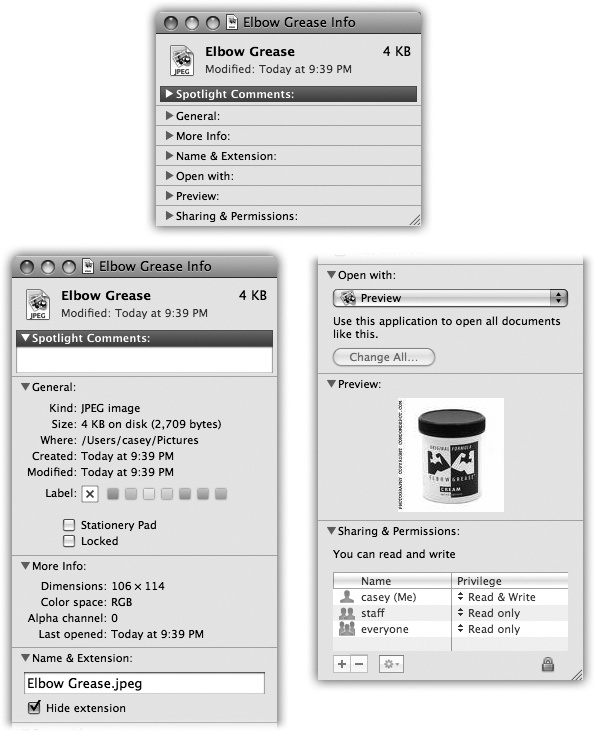By clicking an icon and then choosing File→Get Info, you open an important window like the one shown in Figure 3-8. It’s a collapsible, multipanel screen that provides a wealth of information about a highlighted icon. In essence, this is the Properties window for the icon. For example:
For a document icon, you see when it was created and modified, and what programs it “belongs” to.
For an alias, you learn the location of the actual icon it refers to.
For a disk icon, you get statistics about its capacity and how much of it is full.
If you open the Get Info window when nothing is selected, you get information about the desktop itself (or the open window), including the amount of disk space consumed by everything sitting on or in it.
If you highlight so many icons simultaneously that their Get Info windows would overwhelm your screen, Mac OS X thoughtfully tallies up their information into a single summary window. It shows you how many icons you highlighted, breaks them down by type (“23 documents, 3 folders,” for example), and adds up the total of their file sizes. That’s a great opportunity to change certain file characteristics on numerous files simultaneously, such as locking or unlocking them, hiding or showing their file name suffixes, changing their ownership or permissions (Figure 14-5), and so on.
Figure 3-8. Top: The Get Info window can be as small as this, with all
its information panes collapsed. Bottom: Or, if you click each
flippy triangle to open its corresponding panel of information, it
can be as huge as this—shown here split in two because this box
isn’t enough to show the whole thing. The resulting dialog box can
easily grow taller than your screen, which is a good argument for
either (a) closing the panels you don’t need at any given moment or
(b) running out to buy a really gigantic monitor. There’s a
secret command called Get Summary Info. Highlight a group of icons,
press Control-![]() -I, and marvel at the special Get Info box
that tallies up their sizes and other characteristics.
-I, and marvel at the special Get Info box
that tallies up their sizes and other characteristics.
Tip
You can force the Multiple Item Info dialog box to appear even
if you’ve highlighted only a couple of icons. Just press
Control-![]() -I. (The Option-
-I. (The Option-![]() -I trick described next works for this
purpose, too.)
-I trick described next works for this
purpose, too.)
Spotlight Comments. Here you can type in comments for your own reference. Later, you can view these remarks in any list view if you display the Comments column (Frequently Asked Question: Calculate All Sizes)—and you can find them when you conduct Spotlight searches.
General. Here’s where you can view the name of the icon and also see its size, creation date, most recent change date, locked status, and so on.
If you click a disk, this info window shows you its capacity and how full it is. If you click the Trash, you see how much stuff is in it. If you click an alias, this panel shows you a Select New Original button and reveals where the original file is. The General panel always opens the first time you summon the Get Info window.
More Info. Just as the name implies, here you’ll find more info, most often the dimensions and color format (graphics only) and when the icon was last opened. These morsels are also easily Spotlight-searchable.
Name & Extension. On this panel, you can read and edit the name of the icon in question. The “Hide extension” checkbox refers to the suffix on Mac OS X file names (the last three letters of Letter to Congress.doc, for example).
Most Mac OS X documents, behind the scenes, have file name extensions of this kind—but Mac OS X comes factory-set to hide them. By turning off this checkbox, you can make the suffix reappear for an individual file. (Conversely, if you’ve elected to have Mac OS X show all file name suffixes, then this checkbox lets you hide the extensions on individual icons.)
Open with. This section is available for documents only. Use the controls on this screen to specify which program will open when you double-click this document, or any document of its type.
Preview. When you’re examining pictures, text files, PDF files, Microsoft Office files, sounds, clippings, and movies, you see a magnified thumbnail version of what’s actually in that document. This preview is like a tiny version of Quick Look (Chapter 2). A controller lets you play sounds and movies where appropriate.
Sharing & Permissions. This panel is available for all kinds of icons. If other people have access to your Mac (either from across the network or when logging in, in person), this panel lets you specify who is allowed to open or change this particular icon. See Chapter 14 for a complete discussion of this hairy topic.

